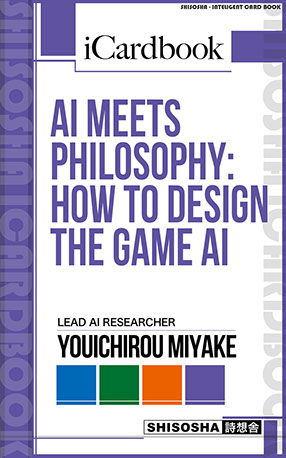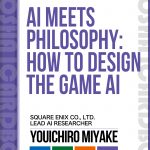Two types of motion-generating methods
There are two types of motion generation methods of game characters. One is to reproduce motion data prepared as data. Another one is to generate motion by itself. The first one is the mainstream of games today.
Tell me more!
Given motion data, movement is simply reproduced in response to the environment, and may be inconsistent with it in some cases. Also, as an exit of intelligence, it can create very limited movements.
This means that the motion data can be considered as constraints. In other words, the character's decision making is limited by physical ability. Expectation for methods to generate motions by itself is estimated to grow.
However, when thinking of AI with a single body, the connection between the part of intelligence, and the part that controls motion, tends to be problematic. Decision making is basically a discrete symbolic system, and motion generation provides continuous motions while interacting with the environment. The next challenge is how to connect these two parts. (“Intelligence and exercise” – iCardbook | https://society-zero.com/icard/771277 )
Just as intelligence is hierarchical, so is a body. Uexküll built a subjective theory which underlay organism in “Umwelt”, and Gibson deepen the understanding on human beings from the psychological point. A Russian physiologist Nikolai Bernstein elaborated on this in the perspective of motion. The main concept in Bernstein's theories, "Cooperation" provides a clue to the connection of intelligence and motion.
Here's reference for the connection between intelligence and movement (books).
Welcome to the world of knowledge that spreads with a click.
【Reference (books) List】
(For more information about the book, click the book title. If you click on the related knowledge card that is under the book title, you can see the context in which these books are selected for reference, which are very useful for an Active Learner.)
Dexterity and Its Development (Resources for Ecological Psychology)
・Bernstein/https://society-zero.com/icard/999853
・Four Stages of Movement Generation/https://society-zero.com/icard/379164
・Co-ordination/https://society-zero.com/icard/161438
Matter and Memory
・Co-ordination of senses and movements/https://society-zero.com/icard/686308
・Motion Perception and Game Characters/https://society-zero.com/icard/117596
・The Duality and Hierarchy of the Body/https://society-zero.com/icard/978847
人工知能のための哲学塾
・Co-ordination/https://society-zero.com/icard/161438
・Motion Perception and Game Characters/https://society-zero.com/icard/117596
・The Duality and Hierarchy of the Body/https://society-zero.com/icard/978847
◎This is a listing of Reference "Chapter 7: Artificial Intelligence for Movement" of 'Artificial Intelligence and Artificial Intellect (Youichiro Miyake)'.
◎You can buy 'Artificial Intelligence and Artificial Intellect (Youichiro Miyake)' at Kindle Store.
■iCardbook Benefits:Good value for reading
・you can read it quickly in your pocket of time, e.g. commuting
・You can immediately understand the "drawing " in the author's head
・Amazon Prime members can read for free
■What is iCardbook?
iCardbook is a card-type specialized book consisting of about 100 pieces of "knowledge card".
"knowledge card" consisting of [Card title + text + references (Books, papers, Web articles, etc.) with hyperlink + footnotes] provides visualizes the knowledge network.
You can read the "design drawing" of professional books during your pocket of time from mobile devices such as smartphones. iCardbook is support kit for an Active Learner
"i" for iCardbook is "i" for inspire, intelligent and innovative.
・Writing that inspires intellectual travelers
・Intelligent writing that invites them to "the world of knowledge" that broaden concern and interest
・Innovative writing that renovates the ecosystem of knowledge.
That's iCardbook.
◎買う前に見て便利|参考文献リスト (It is convenient to see before buying. | References list)
◎Back to References list of "AI meets Philosophy: how to design the Game AI"






